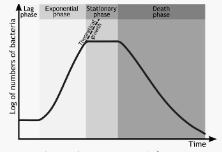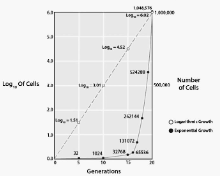If the right conditions are present, microbes can multiply very quickly (such as food and the appropriate temperature). Yeast growing in wort to make beer is an example of something that, depending on the circumstances, could be beneficial or harmful to humans (bacteria growing in your throat causing strep throat). It is critical to have data on their growth so that we can forecast or manage the rate at which they grow in different scenarios.
Microbial growth is evaluated by the increase in population, which can be done by counting the number of cells or the total mass of the organism. Multicellular organisms’ growth is usually assessed in terms of the size of a single organism.
Bacteria are Divided into Groups
In contrast to prokaryotic germs like bacteria and archaea, eukaryotic microorganisms are capable of both sexual and asexual reproduction. Binary fission is the most prevalent kind of cell division found in bacteria and archaea. A single cell will divide into two identical cells throughout this procedure. Other methods, including multiple fission, budding, and spore production, may also occur, but they are far less common.
Cell elongation is the first step, which includes careful expansion of the cell membrane and cell wall, as well as an increase in cell volume. This is done in conjunction with a cell volume increase. The cell begins the process of copying its DNA in order to prepare for the transfer of one of its chromosomes to each of the newly formed cells. The presence of the protein FtsZ is required for the formation of a septum, which appears as a ring in the centre of the elongated cell at first. The septum is completed once the nucleoids have been disseminated to their respective ends of the elongated cell. As a result, the elongated cell is divided into two equal-sized daughter cells. The entire process, also known as the cell cycle, can be completed in as little as twenty minutes in an active culture of E. coli bacteria.
The Growth Curve
Because it is very easy to produce bacteria in the laboratory, the process of their growth has gotten a lot of attention. In a closed system or batch culture (no food provided, no wastes removed), bacteria grow in a predictable fashion, resulting in a growth curve with four different phases: the lag phase, the exponential or log phase, the stationary phase, and the death or decline phase. The lag phase, the exponential or log phase, the stationary phase, and the death or decline phase are listed in this order. This growth curve can also be used to calculate the generation time for a specific organism. The time it takes for the population to double is known as generation time.
The number of cells, the length of each phase, the rate of growth or death, and the total amount of time on each growth curve will vary from organism to organism, and even from one instance of the same organism treated to a different set of environmental circumstances. However, in the vast majority of cases, growth will continue to follow the same four-stage pattern.
Phase of Lag
The bacteria acclimate to their new surroundings during the lag phase, often known as the adaptation period. The length of the lag phase depends on the degree to which the conditions are different from those in which the bacteria originated, as well as the condition of the bacterial cells themselves. Actively growing cells that are shifted from one type of media to another while keeping the same environmental conditions will have the smallest lag time. Damaged cells must first finish the self-repair process before they can begin the process of reproduction, resulting in a significant delay.
During the lag period, cells will normally synthesise RNA, enzymes, and critical metabolites that their new environment may lack (such as growth factors or macromolecules). Changes in the environment, such as temperature, pH, or oxygen supply, will also cause cells to respond. Furthermore, they are most likely mending any damaged cells they encounter.
Either Exponential or Logarithmic Phase
When cells have accumulated everything they need for growth, they move on to the next stage of the process, cell division. The population will double in a predictable manner during the exponential or log phase of growth, going from one cell to two cells, four cells, eight cells, and so on. If the cells are placed in optimum settings, they will develop incredibly quickly (and have a steeper slope on the growth curve), but less-than-ideal conditions would result in slower growth. The bulk of investigations use cells in their exponential phase of growth because they are the healthiest and most uniform. This helps to explain why most experiments start with cells in the exponential phase.
Phase is Stable in Its Place
All good things must come to an end; otherwise, germs would consume enough food to equal the mass of the world in only seven days. Because this is a restricted container, the bacterial population will eventually run out of a required food or chemical, or the bacteria’s growth will be suppressed by the waste products they make. or a lack of physical space, causing the cells to enter a state known as the stationary phase. Either the number of new cells being created equals the number of cells dying off at this stage, or growth has completely stopped, resulting in a flattening of the growth curve. The growth curve will be vertical if growth has totally stopped.
At this point in the process, the cells experience considerable physiological changes as a result of their efforts to acclimatise to their new starving environment. The bacilli’s shape changes to become virtually spherical, and the few new cells generated are substantially smaller in size. Their plasma membranes become less fluid and permeable, and the amount of hydrophobic molecules on the surface increases, all of which encourage cell adhesion and aggregation. The nucleoid condenses to prevent DNA damage, and the DNA becomes coupled with DNA-binding proteins derived from starving cells. The changes are meant to allow the cell to survive for extended periods of time in unfavourable conditions while it waits for more favourable conditions (such as nutrient infusion) to emerge, which may be caused by other processes. Cells that live in low-nutrient environments or in oligotrophic conditions use the same strategies. Cells in the natural world (i.e. outside of the laboratory) are thought to persist in oligotrophic conditions for long periods of time, with only periodic infusions of nutrients returning them to exponential growth for short periods of time. In the laboratory, on the other hand, cells are subjected to carefully regulated settings in which they are allowed to grow at a steady rate.
Cells are more likely to produce secondary metabolites, which are metabolites formed after active growth has occurred and include antibiotics, during the stationary phase of their life cycle. Cells capable of producing an endospore will activate the essential genes during this stage to start the sporulation process. When cells divide into spores, spores are formed.
Death or Decline Equivalent Phase
When the growth curve enters its ultimate stage, the death or decline phase, the number of viable cells starts to decline in a predictable or exponential manner. The rate at which cell viability is reduced is directly related to the steepness of the slope. Because cells taken at this phase do not show evidence of growth when shifted to fresh medium, it is assumed that the culture conditions have deteriorated to the point where the cells have been permanently destroyed. It’s important to keep in mind that if the turbidity of a culture is being tested to assess cell density, measurements may not decrease during this phase because cells may still be viable. This is something that should be taken into account.
Conclusion
Microbes can multiply swiftly under certain conditions (such as food and the appropriate temperature). Yeast in beer wort can be beneficial or detrimental to humans depending on the circumstances (bacteria growing in your throat causing strep throat). We need growth statistics to forecast or control their growth in different circumstances.
Population expansion can be measured by counting cells or the organism’s bulk. Multicellular organisms’ growth is measured by a single organism.
 Profile
Profile Settings
Settings Refer your friends
Refer your friends Sign out
Sign out








